"The thief comes only to steal and kill and destroy; I have come so that they may have life, and may have it abundantly." John 10:10
We have just completed our 6th move since being in the Philippines, and our 23rd move in our married lives! Not that we ever thought that we would move around like this in 20 happy years of marriage, but it is how the Lord has directed so far! And you can see from the picture, we have learned how to move in the Philippines!
We are beginning our 8th year here in the Philippines, and we have been through a lot. We are especially excited that our Palawano friends in Menti have heard the Gospel, we have new families learning tribal languages, and the Lord's work is continuing on here! We just had another missionary finish Tagalog studies, and they are beginning to make plans to move into a tribal area! We have 2 families that just returned from home assignment and they are also preparing to go back into their tribal areas and start studying the tribal language again!
Ginny just finished another year of teaching missionary kids at Faith Academy. It is now summer break for our kids, while the Filipino kids have just started their school year again! (The Filipino school year is June through March, while Faith Academy follows the American system and is August through May.)
So it is good for our girls to have time off for the summer. A well deserved break!
HEALTH STRUGGLES
We have had several people ask about my health condition, so I thought I would take this time to share a little about my experiences delving into the world of food in order to treat a bacterial imbalance in the digestive tract. While I have been busy with the mission work and language coaching, I have had to really grow in this new area of paying attention to my food. My GI condition requires me to eat a regulated, specialized diet. This pretty much leaves out any going out to eat at restaurants, and all my food is prepared from scratch, at home (not that we ate out very often before, but it also precludes ordering pizza or getting a quick Mcdonald's hamburger). All in all, of course, it is probably a healthy thing to eat most of your food prepared from scratch.
I am following the plan of the Specific Carbohydrates Diet (SCD), as outlined in the book, Breaking the Vicious Cycle by Elaine Gottschall. The most challenging thing about this diet, being a restricted diet, is that it also has to be individually tailored to meet the needs of each person that is on it. This tailoring process – a journey through food to discover what works and what doesn't – is what I am in the middle of now. It is also the reason why I cannot come home now and treat the problem – I have to finish the initial phase of this diet (about 1 year) here in the Philippines, without traveling home, or to any of the provinces. So I do my work for the mission mostly from home, and spend a lot of time on skype with the missionaries in various phases of language study.
Just to give some examples of how our lives have changed since I started treating this condition with diet. How did we used to make spaghetti sauce? Just grab a pack of Hunt's tomato sauce, add cooked ground beef and some spices. Can't do that anymore – Hunt's tomato sauce has sugar added as one of the ingredients, as does practically every other major brand of tomato sauce. Sugar becomes food for the bad bacteria causing my condition. So, I have to make my own tomato sauce from tomatoes, and boil it down to the desired thickness. Of course, I can't have spaghetti noodles at all (it is made from wheat flour, a complex carbohydrate which also feeds the bad bacteria). So we cut up thin slices of zucchini and roast them to act as a substitute for spaghetti. It actually is quite tasty. Fortunately, there are a couple of brands available here of Italian canned whole tomatoes which do not have any added sugar or other bad ingredients. When I am able to use those, it saves some time in the preparation.
I am glad I am not having to try and do this in the tribe. There we had to rely on the plane for groceries, and if our supply order was messed up, I would just have to do without. It is much easier when you can just get in the car and drive to the market or grocery store to pick up what you need. Even though my condition is not exceedingly serious, it is significant enough to make it impossible to accomplish successfully without regular access to a grocery store or the like.
Bread – can't eat bread of any kind, just like the gluten free people (my condition is not a gluten allergy). So I have bought almonds, blanched them, ground them up to make almond flour, and made almond flour muffins. They are really good, especially with raisins! I can eat lots of kinds of nuts – but only as long as they are not roasted and put in a can before hand. Why? Because every company that pre-packages nuts for sale in grocery stores adds rice flour to the package in order to make the salt stick onto the nuts they are selling. Rice flour is a big no-no and will quickly nullify all the hard work I have done so far to get my GI tract working properly again. In fact, any ingredient derived from any grain, even if it is whole grain, will cause more damage by becoming food for the bad bacteria. I can, however purchase raw almonds (a bit pricey) and raw cashews (much cheaper here).
For things like soy sauce, ketchup, mayonnaise, salsa, and applesauce, no more of any of that from the store. A-1 Steak Sauce is out – sugar is one of the ingredients. If I want ketchup, I have to make it myself, without sugar or any other forbidden foods. It is not too difficult, but it does take time. Mayonnaise also – I finally started making our old family recipe. Now I wish I had done that years ago, as it is so much better than store bought mayonnaise! Homemade applesauce is delicious, but it is also a lot of work! I was not for working this hard at eating before – now I have to be.
Since everything is regulated and specialized as I slowly expand the diet to learn the kind of things I can and cannot eat, preparing meals for the whole family is a challenge. We eat together, but we do not all eat the same thing. I have my food, and Ginny and the girls have their food. After a few months as my list of edible food expands, we will be able to eat more of the same things. One thing we can share, though, is different kinds of grilled meat (as long as no sauce is put on while grilling, as most sauces you buy have sugar in them).
Fruit is an interesting journey. The sugar in fruit, fructose, is a single molecule sugar, so it should be able to be quickly absorbed in the bloodstream. However, when you have SIBO, the bad bacteria can use fructose as food before it has a chance to be absorbed (fructose malabsorption). So the bad bacteria has to be killed off first, by significantly cutting off even fruit and honey for a week or so. That is where I am now with fruit, and I hope to be able to add some fruit back into my diet within a week to 2 weeks. (see the bottom of this post for a more scientific discussion of sugars)
We have made our own homemade yogurt (fermented for at least 24 hours in order to make sure all the lactose is consumed by the probiotics). We have made homemade yogurt from cow's milk, goat's milk, water buffalo milk, and coconut milk. It is really good, and good for you. This is one of the things that has really helped start the healing process, as the good probiotics in yogurt tend to fight off the bad bacteria.
I will say that I have definitely seen some improvement. I have gained a little weight back, which is a good thing. Even though I have good days and bad days, I am able to keep up with my work for the mission. Also, we were able to move to another house (and there is another story as to why we had to move), without any excessive flare up in my symptoms. It wasn't super easy, but it wasn't as hard as I was expecting. My latest checkup from the doctor cleared me of any possibility of cancer, but it also confirmed my bacterial imbalance.
I will be honest, this has been a very spiritual challenge for all of us, especially for me. I was used to having lots of energy and being able to travel to the tribes when necessary. That has been taken away from us. I don’t fully understand the Lord’s reasons for allowing this in my life, but I do believe he is calling me to fight this and press on in faith. I also believe in the good things He has for our family, as part of His bigger plan for reaching the world with the message of the Gospel, and for drawing us in closer to Himself. We appreciate your prayers as we press on.
Which also brings up another point I would like to mention. It is important to see this from a biblical perspective, and also in the light of eternity. I have recently been in contact with an old friend who faithfully admonished me to hold to the Bible's point of view on sickness.
Acts 10:38 -
"... Jesus from Nazareth, that God anointed him with the Holy Spirit and with power. He went around doing good and healing all who were oppressed by the devil, because God was with him."
There are tons and tons of scriptures that indicate the same thing, and I don't have time or space to list them here. The point is, sickness is part of the work of Satan in this world, and Jesus came to free us from Satan's work. I do not want to get into all kinds of doctrinal discussions on this, as I understand also that the curse of sin is the root cause of sickness and death in this world. But God gave us life and has freed us from the curse, so that we may begin to experience the kingdom of God today.
Don't worry, I am not avoiding doctors or doing anything silly. However, it is important for us to press forward in faith, believing that God is working a healing process in my body.
As I have begun to realize that this is going to be a long-term healing process, it has definitely changed my perspective and affected how I am doing the work for the mission. I have set up several missionaries now to be more self-directed in their language study programs, so that they won't need multiple consultant visits in order to reach level. I also try and interact with people regularly over the computer more, since I cannot go and visit them in the tribes. But it also has drawn me closer, into a deeper relationship with Christ. My life has to become more ordinary, because I don't have all kinds of fantastic trips to tribal areas to write about anymore. It is humbling, but also good. Jesus is the Messiah - I am only His servant.
We have a lot to do over this next year before our home assignment. More missionaries in language study, teaching at Faith Academy, some technical assistance to missionaries for various things, and getting my health under control. All for the purpose of bringing the Gospel to the tribes, for God's glory to be shown in all the Earth!
Blessings on you all in Christ,
George for us all
*For those of you who may be scientifically minded, here is a little tidbit I have learned about digestion. A monosacharride is a type of sugar that has only a single sugar molecule. The villi that line the small intestine will only absorb monosacharride sugars, of which there are 3: fructose, glucose, and galactose. Sucrose, from table sugar, is a disacharride (2 sugar molecules chemically bonded) and has to be broken down by digestive enzymes into glucose before being absorbed into the bloodstream. Starches and complex carbohydrates are all polysacharrides (multiple sugar molecules chemically bonded) and also have to be broken down by digestive enzymes. When there is a bacterial imbalance in the gut, the time that it takes the gut to break down and digest all the disacharrides and polysacharrides also gives the bad bacteria that aren't supposed to be there time to use these as food before they get absorbed into the bloodstream. Thus, the eating of any type of food that has a disacharride or polysacharride source of energy has the potential to exacerbate the problem and cause the bad bacteria to multiply, causing even more damage. Furthermore, the waste products from excessive bad bacteria cause damage to the villi, reducing the villi that are available to absorb the monosacharrides. This has been shown to be a root cause of many intestinal diseases, like Celiacs, Irritable Bowel Disease (IBD), Irritable Bowel Syndrome (IBS), Small Intestinal Bacterial Overgrowth (SIBO), and Crohn’s Disease.
Sunday, June 30, 2013
Bread of Life, Rice of Life
I MEANT TO POST THIS BACK IN APRIL, I AM ONLY GETTING CAUGHT UP AGAIN NOW IN JULY...
“Here in the Philippines, your main food is rice, right?” I asked the guard.
“Yes sir, that's right.”
“So what do you think the main food is in America?”
“Ummm..., bread, right? No wait, potatoes?”
This is how I began a conversation with one of the local neighborhood security guards earlier today. I wanted to get him to think about staple foods and differences in culture, leading into talking about "the bread of life." But before I get into that, just to give a quick update on our current ministries...
The Lord has blessed Ginny's ministry to missionary kids at Faith Academy, as she is able to teach subjects they need to prepare them for moving on. She has also been a devotional speaker in the school's chapel setting, getting the chance to encourage kids from the Word of God and conducted inservice training for Elementary, Middle, and High School teachers.
I currently serve in a ministry primarily aimed at serving other missionaries, in order to equip them to be able to do the work in the tribes by coaching them in their tribal language studies. This has involved a significant amount of traveling over the past 2 years. The combination of excessive travel with an irregular diet gave me a medical condition, such that I can not now travel at all. I have been hit with a somewhat debilitating illness, the only cure of which is to learn how to manage it through a proper diet over a long period of time. The initial stages of this management are very restrictive. However, I have seen some positive growth and feel that I am getting some energy back now that I am a month into the diet. With your prayers and the Lord's blessings, I will be able to travel again later in this year, although I do not expect to regain full strength for at least a couple of years down the road.
Perhaps you are wondering how I can get any work done? Well, the Lord is good. I am able to communicate through the internet to our missionaries in other locations regarding their progress and coach them through their studies. Furthermore, there is plenty of work that I am able to do right here from home, as I develop curriculum and press forward in Tagalog studies (which requires further developing relationships in Tagalog). The curriculum I am working on is how to run a self-study language acquisition course in another language, which I will be teaching to Filipino missionaries that are slated to go to other countries. In addition, I have been asked to help a friend part time that works in this area, who runs a translation ministry where books and other materials are translated from English to Tagalog.
Communicating concepts in another tongue...
As I have mentioned before, we have many missionaries studying many of the different languages here in the Philippines. These are commonly referred to as different “dialects” by your average Filipino, but in truth they are actually different languages by definition. All of us in these contexts are seeking to communicate biblical truth in another language. When learning to communicate biblical principles in another language, culture, language, tradition, and a common understanding must all be taken into account.
To illustrate this principle, let's take the passage from John 6:35.
Jesus said to them, "I am the bread of life. The one who comes to me will never go hungry, and the one who believes in me will never be thirsty....”
Now in the Philippine culture, the word for bread is tinapay. So the first part of this verse could be translated as, “Ako ang tinapay na nagbibigay-buhay.” This literally means, “I am the bread that is giving life.” This is exactly how 2 different Tagalog translations have rendered it.
So here is where we stumble on to a bit of a problem, and it has to do with culture. In the first century Jewish culture, bread was the staple food. So Jesus saying he is “the bread of life” has very profound implications – He is saying that He is what gives life. We should not rely on the physical bread that we need to eat to survive, but on the one true source of life – Jesus.
Since bread was the primary staple food of the Jews in the first century, and not only them but many other peoples of the surrounding nations in the Roman Empire of the time, this statement communicated exactly as Jesus intended it to his audience. In the wider European culture over the centuries, it continued to communicate, and when Europeans came to the New World, this idea stayed with them, for bread is still the primary staple food of most if not all Western countries on both sides of the ocean. In America today, bread is probably still considered the primary staple food, but we have other substitutes for it in our meals, like potatoes, rice, and corn. So to us, this idea of the “bread of life” still can carry significant meaning, although sometimes it has to be explained a little more to someone who is new to the idea.
As you move into the native New World cultures, you find that some of them have corn, and others, potato, and some others cassava as their primary staple food. So perhaps in those contexts quite a bit of explanation is needed to expound on the idea of “the bread of life,” or even the use of a different term besides “bread.”
Here in the Philippines, rice is the main staple, not bread. They do eat bread, but mostly only for breakfast in small rolls called “pandesal.” Yet the translations here still use the term “tinapay” – bread – to communicate the idea. Why is that? Well, at first I thought this was because of the influence of the last hundred plus years of Protestant missionaries. However, upon further investigation, I realized it goes much deeper than that. The four hundred plus years of Spanish government here in the Philippines, with a strict Catholic influence, drilled into the minds of the people the significance of bread in the religious sense. The host, which is used in the Catholic mass, is a type of bread, not rice. The scriptural imagery of bread developed into a literal illustration in the rites of the Catholic church over the centuries in Europe, and was brought here to the Philippines. This tradition has been carried on into many Protestant denominations as well, so that many of the bible translations into lowland Philippine languages use the term “tinapay”.
Now because rice is the main staple here instead of bread, if we strictly translated the meaning of the English to Tagalog, we would probably translate John 6:35 as “ang kanin ng buhay” - the rice of life. However, if you say this to a Filipino, Christian or otherwise, they don't like it.
To verify this, I went out into our neighborhood just to ask around. These kind of discussions make for interesting conversations, to be sure! My conclusion after talking with people is that it feels almost like sacrilege to say the term “the rice of life.” In using that phrase with some Filipino friends, they all responded the same way – it was more than just sounding peculiar. It sounded “ugly” (as they would put it).
Ultimately, culture goes beyond just the use of words. It goes to a deeper understanding of the meanings and cultural implications of those words. In the national Filipino culture, there is a very strong Catholic influence, and so the phrase “bread of life” has taken on a meaning influenced by that. (I read that some Asian bible translations actually do use the phrase “rice of life,” but I looked up several, and the ones I found and put into Google translate still use the phrase “bread of life,” indicating this influence goes beyond just the Philippines.)
This presents a problem. If we want to communicate the original meaning in such a way that it does not sound foreign, we must use concepts and ideas that are not foreign. The only exceptions to this are when the concepts don't have an equivalent meaning in the target culture. For example, take the phrase “The Lamb of God,” and try to explain it to the mountain Palawanos, who have never seen or heard of an animal like that or any kind of sheep. Some of them may have seen goats that are raised by lowland Filipinos, but not sheep. In a case like that, an explanation of what the animal is, with pictures, and how it fit into the Jewish sacrificial system is necessary.
However, bread as a staple food is not like that. A staple food is a basic component of all human cultures, so we have missed out by always forcing the translation to read from the Western point of view and always using the term “bread,” when a more appropriate cultural equivalent would have communicated more effectively.
The Palawano translation for where we used to live translates it like this:
“Ako,” kuan yey, “pegkaan na ikebiag."
Translated back to English:
"I," he said, "am the food that gives life/makes alive."
The translators here used the generic term “pegkaan” which means food. The Palawanos live on rice for about half the year, and then their rice runs out so they live on cassava. Furthermore, they are also hunter-gatherers in the jungle, so they have many varieties of food to choose from besides only rice. Even though rice is their main staple, there are other options. So the generic term “food” fits the context much better.
The Palawano word for life, “biag” is the same as the word for “full.” I remember taking Palawanos into town sometimes for treatment, and one old man remarked to me once that if we could all live in town, they would never die of starvation. “Food that gives life” and “Food that makes a full stomach” are one and the same concept to them. So the translation must clearly indicate that the food we are referring to is about more than just having a full stomach. There again is where an understanding of both the language and culture play a key role.
Now consider a teaching like this. “Jesus did not come to give bread, but to be bread” (John Piper). In Tagalog, the literal translation would be, “Hindi pumunta rito si Jesus para magbigay ng tinapay, bagkus para maging tinapay.” However, the meaning gets lost on the word “tinapay” (bread), because Filipinos only eat bread sometimes in the morning and sometimes for a snack.
That is why it would be better to explain it like this, “Hindi pumunta rito si Jesus para magbigay ng pagkain, bagkus para maging pagkain.”
Literally, that is saying, “Jesus did not come to give food, but to be food.”
The idea here is that our true sustenance in life, both physical and spiritual, comes from Jesus. There are times when we go through difficulties and hardships, and where we may even lack food. However, Jesus is always our source of life, and the life He gives is eternal. This is where our focus should lie, and this is what we should pass on to others.
Since Palawanos have little to no concept of bread, calling Jesus “the bread of life” to them would have no meaning. All they know about bread is that it is what the downriver Filipinos eat for breakfast a couple of times a week. Furthermore, identifying Jesus with only one exclusive type of food (rice), when they have many types of food, would distort the meaning. Therefore, the use of the generic term for food communicates the concept most effectively.
These are all things that we have to think about when we want to communicate God's truth in another language.
Applying this to life
As I tie all this back into my own life, my physical condition right now is such that I cannot eat any bread. Neither can I eat rice, corn, oats, barley, or anything else that is a grain or derived from any sort of grain. I am not supposed to have even half a teaspoonful of anything like that. Neither can I eat anything with table sugar, mixed in (which makes up about 90% of any kind of processed food in the Philippines). There are other restrictions also, like no soy, avoid legumes, and be very careful with fiber. Everything I eat now has to be made from scratch, which is why I am confined to doing everything from home for the time being. It is not a gluten-free diet; it is a grain-free diet with other restrictions. (If you want to find out more, check out the book Breaking the Vicious Cycle by Elaine Gottschall.) Over time, as my digestive track slowly heals, I will be able to add back into my diet the foods I used to eat.
It would be easy (and demoralizing) to always be thinking about what I cannot eat. Instead, I focus on remembering that Jesus is the Bread of Life. He is also the Rice of Life and whatever other staple food might fit in there. He is Life. Life for me, life for you, life for us all. We fully trust and believe in His promises, and are sustained by Him every day. May he not only fill our stomachs, but also our hearts, souls, and spirits. May we take Him by faith as the one who sustains us through life!
And now that the game has changed for my eating, I am finding that there is a wide variety of things I can do with food that don't involve grains or sugar, so that food can still be an enjoyable part of life. It is a learning and growth period for us, but that is all part of what we are doing here! Do you see how the Lord Jesus sustains us?
We thank you for your continued prayers and support as we serve the Lord here in the Philippines! Please pray for my continued healing, our kids as they press on in their studies and work, and the work God is doing in the Philippines! We are very thankful to be able to serve here!
In Christ for us all,
George
With Ginny, Sarah, and Abby (Isaac in the USA)

Sarah was in the school's production of "Beauty and the Beast." It was a great performance!

We had some friends from Texas come to visit!

We were able to drive to downtown Manila and see some cultural sights!

Passing by this bookstore in the middle of a construction zone, with a "Business as Usual" sign above the door!

This is the rental house we will move to next month!
“Here in the Philippines, your main food is rice, right?” I asked the guard.
“Yes sir, that's right.”
“So what do you think the main food is in America?”
“Ummm..., bread, right? No wait, potatoes?”
This is how I began a conversation with one of the local neighborhood security guards earlier today. I wanted to get him to think about staple foods and differences in culture, leading into talking about "the bread of life." But before I get into that, just to give a quick update on our current ministries...
The Lord has blessed Ginny's ministry to missionary kids at Faith Academy, as she is able to teach subjects they need to prepare them for moving on. She has also been a devotional speaker in the school's chapel setting, getting the chance to encourage kids from the Word of God and conducted inservice training for Elementary, Middle, and High School teachers.
I currently serve in a ministry primarily aimed at serving other missionaries, in order to equip them to be able to do the work in the tribes by coaching them in their tribal language studies. This has involved a significant amount of traveling over the past 2 years. The combination of excessive travel with an irregular diet gave me a medical condition, such that I can not now travel at all. I have been hit with a somewhat debilitating illness, the only cure of which is to learn how to manage it through a proper diet over a long period of time. The initial stages of this management are very restrictive. However, I have seen some positive growth and feel that I am getting some energy back now that I am a month into the diet. With your prayers and the Lord's blessings, I will be able to travel again later in this year, although I do not expect to regain full strength for at least a couple of years down the road.
Perhaps you are wondering how I can get any work done? Well, the Lord is good. I am able to communicate through the internet to our missionaries in other locations regarding their progress and coach them through their studies. Furthermore, there is plenty of work that I am able to do right here from home, as I develop curriculum and press forward in Tagalog studies (which requires further developing relationships in Tagalog). The curriculum I am working on is how to run a self-study language acquisition course in another language, which I will be teaching to Filipino missionaries that are slated to go to other countries. In addition, I have been asked to help a friend part time that works in this area, who runs a translation ministry where books and other materials are translated from English to Tagalog.
Communicating concepts in another tongue...
As I have mentioned before, we have many missionaries studying many of the different languages here in the Philippines. These are commonly referred to as different “dialects” by your average Filipino, but in truth they are actually different languages by definition. All of us in these contexts are seeking to communicate biblical truth in another language. When learning to communicate biblical principles in another language, culture, language, tradition, and a common understanding must all be taken into account.
To illustrate this principle, let's take the passage from John 6:35.
Jesus said to them, "I am the bread of life. The one who comes to me will never go hungry, and the one who believes in me will never be thirsty....”
Now in the Philippine culture, the word for bread is tinapay. So the first part of this verse could be translated as, “Ako ang tinapay na nagbibigay-buhay.” This literally means, “I am the bread that is giving life.” This is exactly how 2 different Tagalog translations have rendered it.
So here is where we stumble on to a bit of a problem, and it has to do with culture. In the first century Jewish culture, bread was the staple food. So Jesus saying he is “the bread of life” has very profound implications – He is saying that He is what gives life. We should not rely on the physical bread that we need to eat to survive, but on the one true source of life – Jesus.
Since bread was the primary staple food of the Jews in the first century, and not only them but many other peoples of the surrounding nations in the Roman Empire of the time, this statement communicated exactly as Jesus intended it to his audience. In the wider European culture over the centuries, it continued to communicate, and when Europeans came to the New World, this idea stayed with them, for bread is still the primary staple food of most if not all Western countries on both sides of the ocean. In America today, bread is probably still considered the primary staple food, but we have other substitutes for it in our meals, like potatoes, rice, and corn. So to us, this idea of the “bread of life” still can carry significant meaning, although sometimes it has to be explained a little more to someone who is new to the idea.
As you move into the native New World cultures, you find that some of them have corn, and others, potato, and some others cassava as their primary staple food. So perhaps in those contexts quite a bit of explanation is needed to expound on the idea of “the bread of life,” or even the use of a different term besides “bread.”
Here in the Philippines, rice is the main staple, not bread. They do eat bread, but mostly only for breakfast in small rolls called “pandesal.” Yet the translations here still use the term “tinapay” – bread – to communicate the idea. Why is that? Well, at first I thought this was because of the influence of the last hundred plus years of Protestant missionaries. However, upon further investigation, I realized it goes much deeper than that. The four hundred plus years of Spanish government here in the Philippines, with a strict Catholic influence, drilled into the minds of the people the significance of bread in the religious sense. The host, which is used in the Catholic mass, is a type of bread, not rice. The scriptural imagery of bread developed into a literal illustration in the rites of the Catholic church over the centuries in Europe, and was brought here to the Philippines. This tradition has been carried on into many Protestant denominations as well, so that many of the bible translations into lowland Philippine languages use the term “tinapay”.
Now because rice is the main staple here instead of bread, if we strictly translated the meaning of the English to Tagalog, we would probably translate John 6:35 as “ang kanin ng buhay” - the rice of life. However, if you say this to a Filipino, Christian or otherwise, they don't like it.
To verify this, I went out into our neighborhood just to ask around. These kind of discussions make for interesting conversations, to be sure! My conclusion after talking with people is that it feels almost like sacrilege to say the term “the rice of life.” In using that phrase with some Filipino friends, they all responded the same way – it was more than just sounding peculiar. It sounded “ugly” (as they would put it).
Ultimately, culture goes beyond just the use of words. It goes to a deeper understanding of the meanings and cultural implications of those words. In the national Filipino culture, there is a very strong Catholic influence, and so the phrase “bread of life” has taken on a meaning influenced by that. (I read that some Asian bible translations actually do use the phrase “rice of life,” but I looked up several, and the ones I found and put into Google translate still use the phrase “bread of life,” indicating this influence goes beyond just the Philippines.)
This presents a problem. If we want to communicate the original meaning in such a way that it does not sound foreign, we must use concepts and ideas that are not foreign. The only exceptions to this are when the concepts don't have an equivalent meaning in the target culture. For example, take the phrase “The Lamb of God,” and try to explain it to the mountain Palawanos, who have never seen or heard of an animal like that or any kind of sheep. Some of them may have seen goats that are raised by lowland Filipinos, but not sheep. In a case like that, an explanation of what the animal is, with pictures, and how it fit into the Jewish sacrificial system is necessary.
However, bread as a staple food is not like that. A staple food is a basic component of all human cultures, so we have missed out by always forcing the translation to read from the Western point of view and always using the term “bread,” when a more appropriate cultural equivalent would have communicated more effectively.
The Palawano translation for where we used to live translates it like this:
“Ako,” kuan yey, “pegkaan na ikebiag."
Translated back to English:
"I," he said, "am the food that gives life/makes alive."
The translators here used the generic term “pegkaan” which means food. The Palawanos live on rice for about half the year, and then their rice runs out so they live on cassava. Furthermore, they are also hunter-gatherers in the jungle, so they have many varieties of food to choose from besides only rice. Even though rice is their main staple, there are other options. So the generic term “food” fits the context much better.
The Palawano word for life, “biag” is the same as the word for “full.” I remember taking Palawanos into town sometimes for treatment, and one old man remarked to me once that if we could all live in town, they would never die of starvation. “Food that gives life” and “Food that makes a full stomach” are one and the same concept to them. So the translation must clearly indicate that the food we are referring to is about more than just having a full stomach. There again is where an understanding of both the language and culture play a key role.
Now consider a teaching like this. “Jesus did not come to give bread, but to be bread” (John Piper). In Tagalog, the literal translation would be, “Hindi pumunta rito si Jesus para magbigay ng tinapay, bagkus para maging tinapay.” However, the meaning gets lost on the word “tinapay” (bread), because Filipinos only eat bread sometimes in the morning and sometimes for a snack.
That is why it would be better to explain it like this, “Hindi pumunta rito si Jesus para magbigay ng pagkain, bagkus para maging pagkain.”
Literally, that is saying, “Jesus did not come to give food, but to be food.”
The idea here is that our true sustenance in life, both physical and spiritual, comes from Jesus. There are times when we go through difficulties and hardships, and where we may even lack food. However, Jesus is always our source of life, and the life He gives is eternal. This is where our focus should lie, and this is what we should pass on to others.
Since Palawanos have little to no concept of bread, calling Jesus “the bread of life” to them would have no meaning. All they know about bread is that it is what the downriver Filipinos eat for breakfast a couple of times a week. Furthermore, identifying Jesus with only one exclusive type of food (rice), when they have many types of food, would distort the meaning. Therefore, the use of the generic term for food communicates the concept most effectively.
These are all things that we have to think about when we want to communicate God's truth in another language.
Applying this to life
As I tie all this back into my own life, my physical condition right now is such that I cannot eat any bread. Neither can I eat rice, corn, oats, barley, or anything else that is a grain or derived from any sort of grain. I am not supposed to have even half a teaspoonful of anything like that. Neither can I eat anything with table sugar, mixed in (which makes up about 90% of any kind of processed food in the Philippines). There are other restrictions also, like no soy, avoid legumes, and be very careful with fiber. Everything I eat now has to be made from scratch, which is why I am confined to doing everything from home for the time being. It is not a gluten-free diet; it is a grain-free diet with other restrictions. (If you want to find out more, check out the book Breaking the Vicious Cycle by Elaine Gottschall.) Over time, as my digestive track slowly heals, I will be able to add back into my diet the foods I used to eat.
It would be easy (and demoralizing) to always be thinking about what I cannot eat. Instead, I focus on remembering that Jesus is the Bread of Life. He is also the Rice of Life and whatever other staple food might fit in there. He is Life. Life for me, life for you, life for us all. We fully trust and believe in His promises, and are sustained by Him every day. May he not only fill our stomachs, but also our hearts, souls, and spirits. May we take Him by faith as the one who sustains us through life!
And now that the game has changed for my eating, I am finding that there is a wide variety of things I can do with food that don't involve grains or sugar, so that food can still be an enjoyable part of life. It is a learning and growth period for us, but that is all part of what we are doing here! Do you see how the Lord Jesus sustains us?
We thank you for your continued prayers and support as we serve the Lord here in the Philippines! Please pray for my continued healing, our kids as they press on in their studies and work, and the work God is doing in the Philippines! We are very thankful to be able to serve here!
In Christ for us all,
George
With Ginny, Sarah, and Abby (Isaac in the USA)

Sarah was in the school's production of "Beauty and the Beast." It was a great performance!

We had some friends from Texas come to visit!

We were able to drive to downtown Manila and see some cultural sights!

Passing by this bookstore in the middle of a construction zone, with a "Business as Usual" sign above the door!

This is the rental house we will move to next month!
video of some of our recent work
One of our sponsoring churches put together a video of our work in the Philippines. Here is the link to the page where you can view the video:
http://www.dwtx.org/department-ministries/world-mission/
http://www.dwtx.org/department-ministries/world-mission/
End of 2012 in Pictures
NOTE THIS IS AN OLD POST FROM 2012
2012 was a very adventurous year, with lots of travels. You can read about it in our end of the year post on our website by clicking here.
I will have to say, in the last half of 2012, I have started experiencing some significant gastro-intestinal difficulties. I hope this doesn't affect my ability to travel in 2013.
2012 was a very adventurous year, with lots of travels. You can read about it in our end of the year post on our website by clicking here.
I will have to say, in the last half of 2012, I have started experiencing some significant gastro-intestinal difficulties. I hope this doesn't affect my ability to travel in 2013.
NOTE - THIS IS AN OLD POST FROM 2012
November 25, 2012
Palawan again – week of September 9
As I write this at the end of my travels for the year, I am amazed at the work God is doing. Even though it has been difficult for me to travel while trying to maintain a somewhat restricted diet, the Lord has gone before us in our travels and prepared the way.
This update will encompass the scope of my return to Palawan, a visit into 3 tribal areas, and then finally a visit to Mindanao at the end which I will briefly touch on. It will also include some about Ginny and her work at Faith Academy, and how the Lord is doing great things in our lives. We are incredibly thankful for the goodness of God in allowing us to serve Him, and we pray together with you all we will continue to grow in His wisdom, knowledge, and love!
Return to Palawano for a (very) short visit, week of Sept 16...
When I first took on the job of being a language consultant, it was decided that I should always have someone to accompany me, as it greatly helps in the work. This time, our original plans fell through, so we had to scramble to find an assistant for the consultant visit.
The missionary who trained me to do this kind of work, Jody Crain, was returning to the Philippines for his other ministries for only about a month, so we asked him if he would accompany me. In this way he agreed to come and act as my assistant for this round of evaluations.
I went to Palawan ahead of him so that I could fly to our old tribal area first and make a final walk-through of our house there. There I visited with many Palawano friends and our old partners. I have been out of the Palawano language for over a year, but it quickly just came right back! What a blessing to still be able to recall enough to visit with some of my old friends, although most of them were out in their fields working.
Talking to our old partners was an opportunity to catch up on what is going on there, and they told me a little about the teaching and how the people are receiving it. They are teaching a small group in our old village, and then have plans to soon begin teaching in another village downriver from us. And as of the time of this writing, we have just found out that after presenting the death, burial, and resurrection of Christ, there are 5 new Palawano believers. Wow, praise the Lord!
After about 3 hours in our old location, we (the pilot and I) flew back to Puerto Princesa. Too bad it was so short, but the weather sets in early there, and we had to leave before the rains came or we would not be able to fly. The next day Jody arrived, and together we flew up to the north end of the island to an area where our missionaries are working in the Tagalog language.
Northern Palawan tribal area...
This area in the North is a bit unique for the Philippines. The missionary who started the work here was hoping to begin a work with the Tagbanua tribal people that lived there. Over the years, more and more Filipinos from other areas began moving in. At first the dominant language was Cuyonin (having supplanted the Tagbanua language), but now Tagalog has taken over as dominant with the influx of even more immigrants. So, when partners joined the original missionaries there, they believed it would be best to do the ministry in the Tagalog language. It is unusual for us to have a tribal ministry which is conducted in the national language, but it fits with the needs of the people in this area.
The other uniqueness of this area is that many of the Filipinos there do not have strong family ties. In the Filipino culture, maintaining strong family ties throughout life is the norm, and often grown children with their wives and their own families will be found living with one or more sets of parents and even siblings. However, the people at this end of the island seem to be group of outcasts (sort of). Since they migrated there for one reason or another, they have managed to loosely sever their family ties back to their respective home areas. Also, because Tagalog is the only common language they all share, they practice it and use it every day, and have become highly proficient in it (even though for most of them it is not their first language).
So in this environment, there is a little church where the missionaries are discipling the believers. The missionary we were there to do a final language check on has not been teaching in the church, because our mission requires close to proficient level of certification before teaching in a church. Instead, he has been discipling one on one with some of the leading men in the church, and the reports he gave about the response of the church members to their preaching have been astounding. He told of one instance where he was going through the book of Romans and talking about things that hold us in bondage. He asked the man he was discipling what people are in bondage to in their area. The immediate response was “superstitions.” The following Sunday, this young man was preaching through the book of Romans on how superstitions were keeping them in bondage and preventing them from fully trusting in God. There was an overwhelming response, as people began to discuss how to throw away their dependencies on amulets, good luck charms, and other superstitions in order to trust in Christ alone.
It is very exciting to see God working in people's lives in this way. The missionary there had been doing very well in language and culture studies, and had very strong relationships with the people in the area. The result of the evaluation was that he was clearly ready to move into a preaching and teaching role as necessary for the church.
While we were there, a big typhoon came through the Philippines and the residual effects in our area were very strong. Huge waves were crashing on the beach, and knowing that we were due in a couple of days to cross that ocean on a small boat, we had some cause for concern. I sent a text message to some Christian friends of ours in Manila asking them to pray for our travels, as the storm did not show signs of letting up within the time necessary for us to cross over to the other island.
When the morning came for us to leave our location and drive across the island to the embarkation point, the weather cleared up, but the ocean was still rough at first. We had a text message from the missionary at our destination saying that he thought the weather was calm enough to make the crossing, and he was proceeding out on his boat with the 2 local boat drivers. We arrived at the pick up point about the same time as he was making land, and by that time the weather and the waves were very calm! We made the smoothest crossing I have ever made to that island in record time, praise the Lord! It turned out that at the last minute the typhoon had turned sharply North, and we were left with clear skies and calm seas.
On the island of X…,
We arrived feeling thankful for the Lord going before us in getting us safe to the island. Back to back evaluations are a lot of work, and here we were working with both Nate and Megan, the same couple that we originally came with to the Philippines over 6 years ago. They are good friends of ours, and so it was really nice to visit with them.
This is a small island that has become a center for trade in squid fishing. The fishing has recently become so lucrative that many people from islands all over the Visayas have moved to this area. However, Cuyonin has remained the dominant language here, even though Tagalog is spoken and understood. One of the local people told me that if a new Filipino moves to the island, that person is expected to learn Cuyonin if he or she wants to have friends. So naturally, the missionaries there are also studying Cuyonin.
This time on the island, we were briefed on the team's plans to soon be teaching the Gospel lessons to the islanders. If you remember from earlier this year, the first missionary there for whom we did a language assessment had already reached his required proficiency level in language, and so has been hard at writing Bible lessons to present to the people. He has worked really hard, so that from the time in which he reached the required level to the time in which the Bible lessons were written has only been about 4 months! This is a very exciting time for the island, because soon the people there will hear the message of Christ, when God reached down to restore His relationship to mankind.
Our consultant visit here was to assist the progress of Nate and Megan in their language acquisition, so that they will be able to help the original missionary with the Gospel teaching. They too have been working hard, and are now both at their required proficiency level. After the assessment, we took a boat back to Palawan, caught a bus back to Puerto Princesa, and flew home. Wow, it was a busy month!
One month of not traveling
The month of October gave us an opportunity to catch up on some needed administrative work with the mission, as well as start working on figuring out what is going on with us health-wise. We are also now into the middle of our 2nd year from when we left the tribe to be based out of Manila, and we have found the right niche for our family life and for the ministry. (This is also the beginning of our 7th year in the Philippines.) Ginny is enjoying teaching missionary kids; we are doing well with our girls at home, and when I am at home I am able to continue to press on in deeper acquisition of the Tagalog language. I have learned more and more about how language study never really stops if you want to get really good in it. We now are developing some close friendships with Filipinos in the area, and are enjoying our time together when I am home.
November saw another round of travels (Mindanao)
In November, I was able to travel down to Mindanao and finish a language evaluation on the 2 missionaries studying Visayan down there, Brian and Brooke. They are opening up our Visayan language program for the new folks that choose to work in Mindanao. It was necessary for Brian and Brooke to reach a required proficiency level in speaking Visayan before they started teaching it to others. They have been working very hard for a long time, and they demonstrated their ability well. This is really good news for us, because now we can proceed ahead with our new missionaries studying Visayan.
Just as a reminder for clarification if this is confusing. Here in the Philippines, there are over 170 languages and 3 principal regional trade languages. In the North, the trade language is Ilocano. In the South (Mindanao) and the Visayan Islands, the trade language is Visayan (also called Cebuano). In Central Luzon and Palawan, the trade language is Tagalog, which is also the national language and is spoken throughout the whole country. In New Tribes Mission, we have 2 national language programs for new missionaries – Tagalog for the North and Central part of the country, and Visayan for Mindanao and the Visayan islands.
The reason we don't have an Ilocano language program is that Tagalog is also fairly strong in the Northern Philippines, enough to warrant its usefulness there and over-riding the need for an Ilocano language program.
However, that is not the case in Mindanao; hence, we have a Visayan language program there. After spending almost 2 weeks in Mindanao, I had some observations to make. First of all, compared to the Northern Philippines where you hear Tagalog and Ilocano whenever you go out, here in Mindanao you don't hear Tagalog and Visayan when you go out. You pretty much only hear Visayan. The people understand and can speak some Tagalog because they learn it in school and watch it on TV, but Visayan is still much more dominant here compared to Tagalog. However, when people found out that I could speak Tagalog, they were very eager to practice it with me, because they don't often meet someone to practice Tagalog with. (This is unlike Manila, where most Filipinos want to practice English with me and so I have to work to find people willing to speak Tagalog.) Apparently in this area of Mindanao, fluency in Tagalog brings possibilities of business and opportunity.
So it was great to spend a couple of weeks in Mindanao – the last time I was there was almost 7 years ago when I took Isaac along with me on a survey trip of the tribes in the area. It is hard to believe it was that long ago.
After finishing the evaluations, we spent a week talking through the details of how we are going to structure the Visayan language program for new missionaries. This was a very profitable time, and we are very thankful for Brian and Brooke spearheading this ministry!
Finally...
And as a final report, remember our friends on the island where I did the check in September? Well, we just received the report that they are now teaching the people through the Bible, in the Cuyonin language. So exciting to see the work God is doing there!
Blessings to you all in Christ,
George for all of us
George, Ginny, Isaac, Sarah, & Abby
PICTURES:
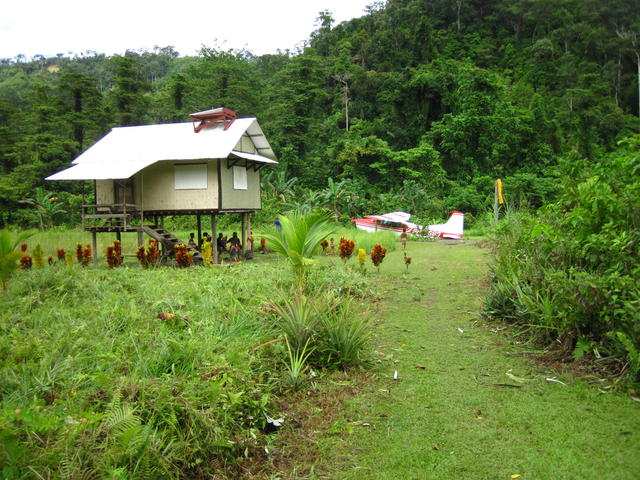
Flew into our tribe one last time, said good-bye :(
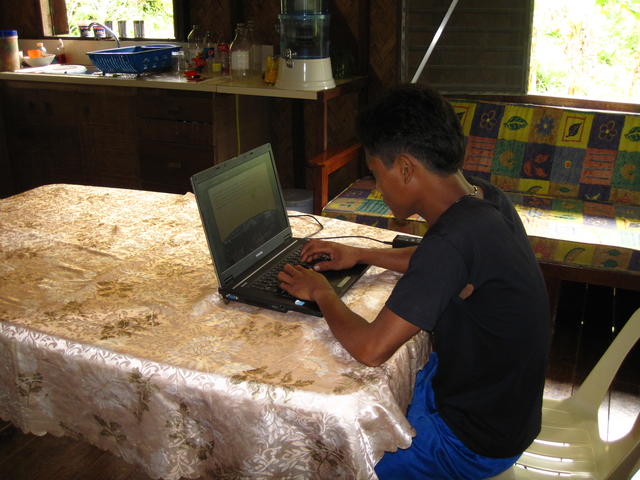
Saw that our partners were teaching the tribal people to type on the computer so that they can one day develop their own lessons
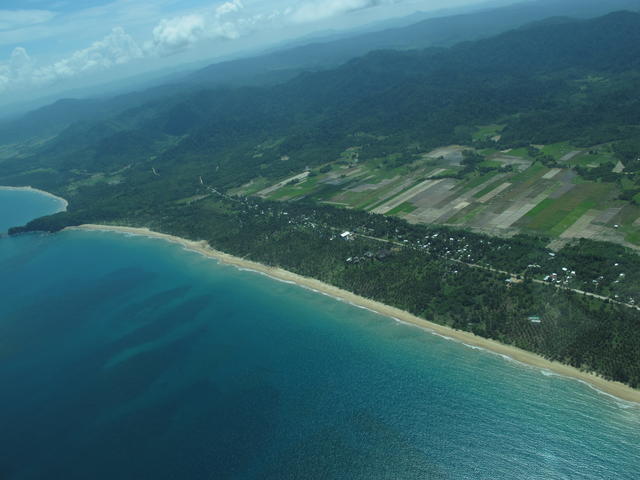
Flew up to Northern Palawan to visit a tribal area and do language evaluations on the missionaries there
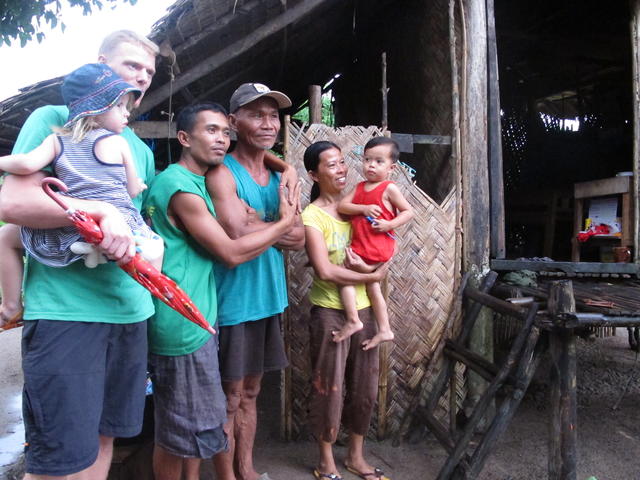
Here is the missionary with one of the young men who is a leader in the church.
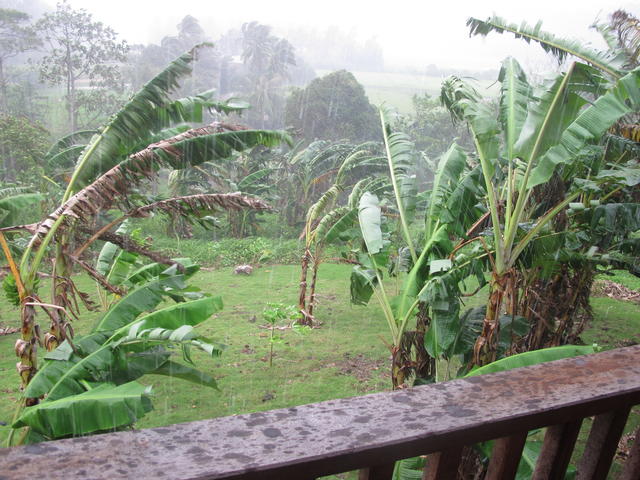
Typhoon came through, was blowing really hard
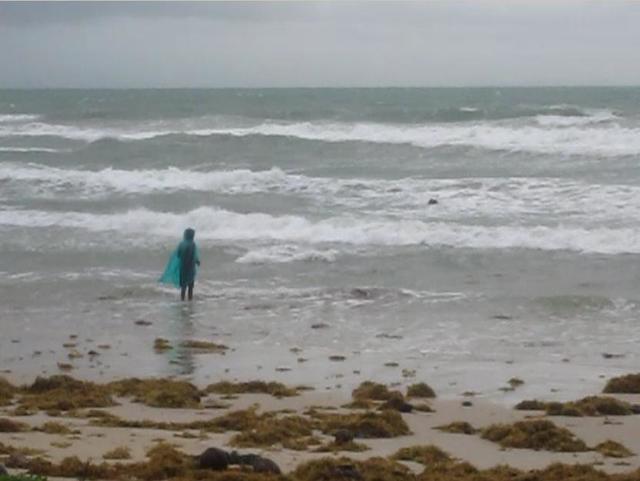
Waves were too big for crossing the ocean
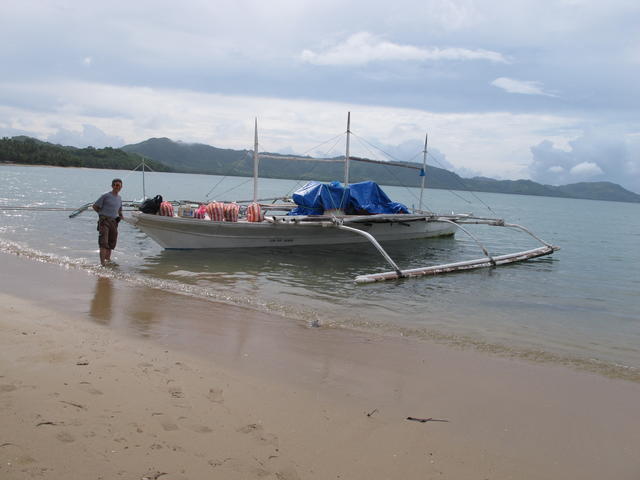
But when it came time to move, the storm subsided
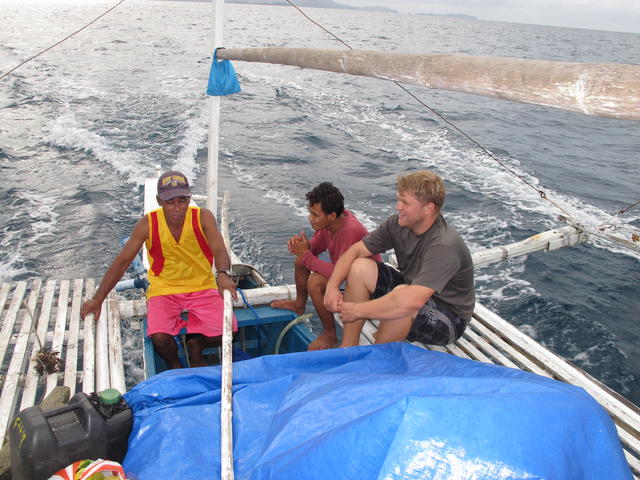
we crossed in calm seas
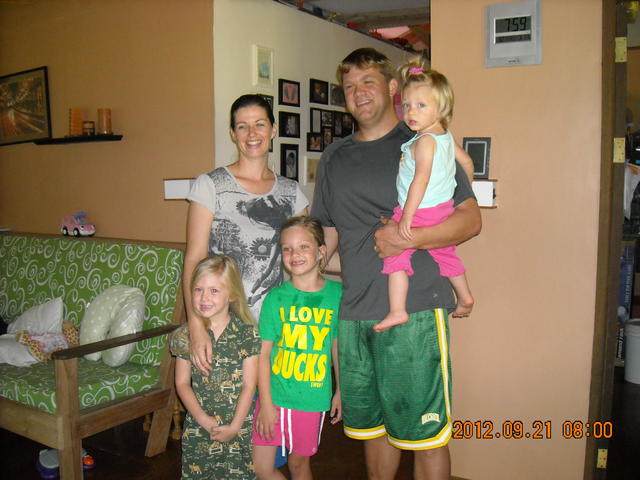
Here is the precious missionary family studying on the island and preparing to teach the Gospel
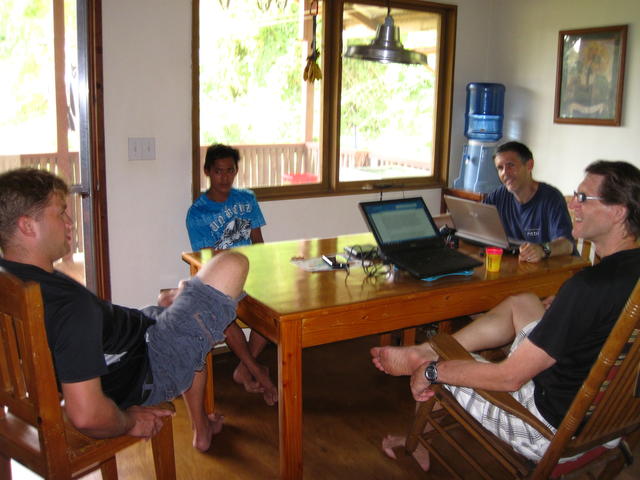
Here we are in one of our sessions where we are talking about the language and culture of the island
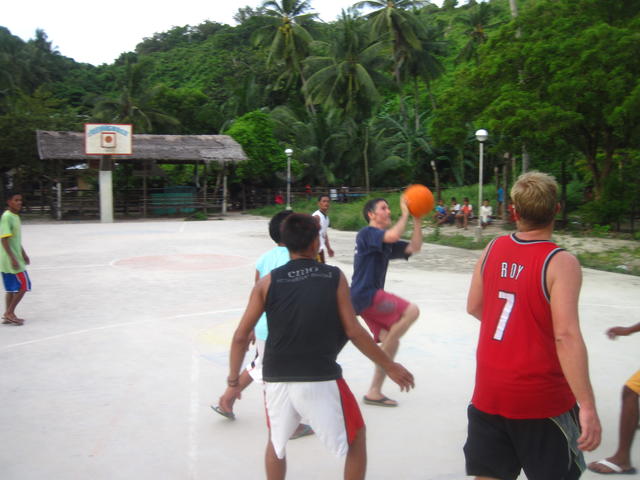
They got me to play basketball - the last time I played basketball was in junior high, I think, and they called me dr. J (for dr joke)

We do more than just language assessments - I had an opportunity to help Nate out with his solar electric system
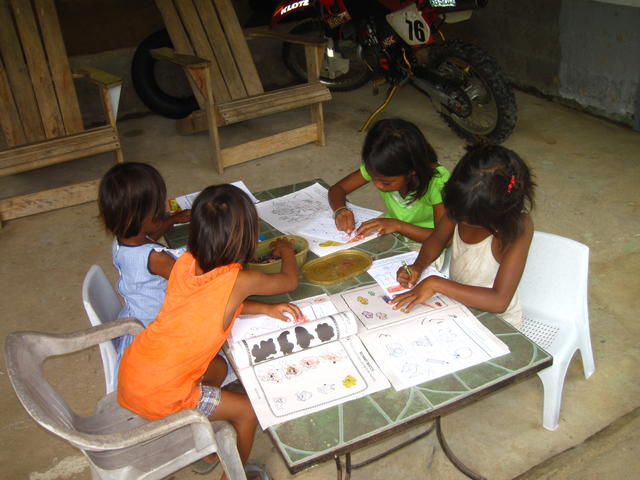
Where they are beginning to let the kids in the village learn to read and write
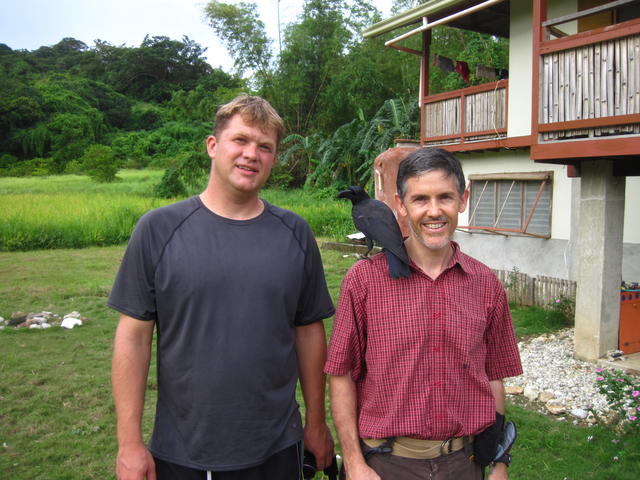
The family had a pet crow that was very friendly
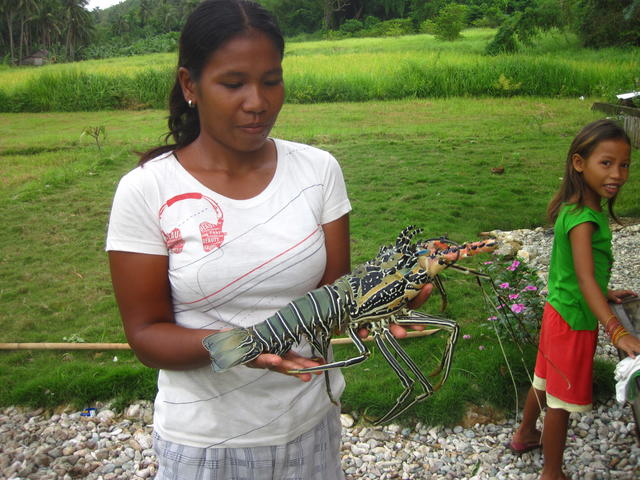
Lady came by selling a lobster she had just caught
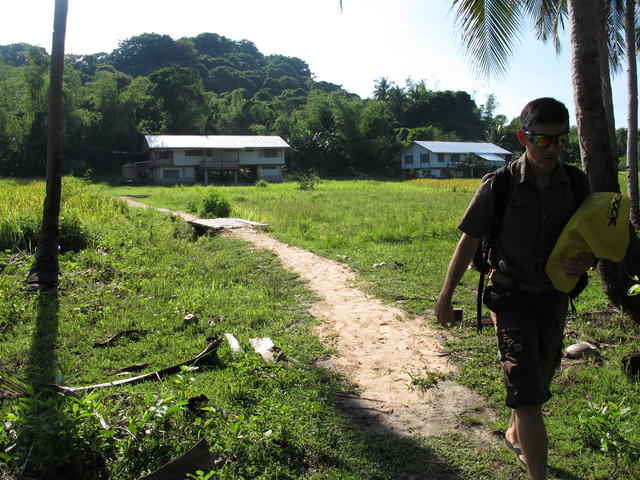
Upon leaving, we said good by and hiked out
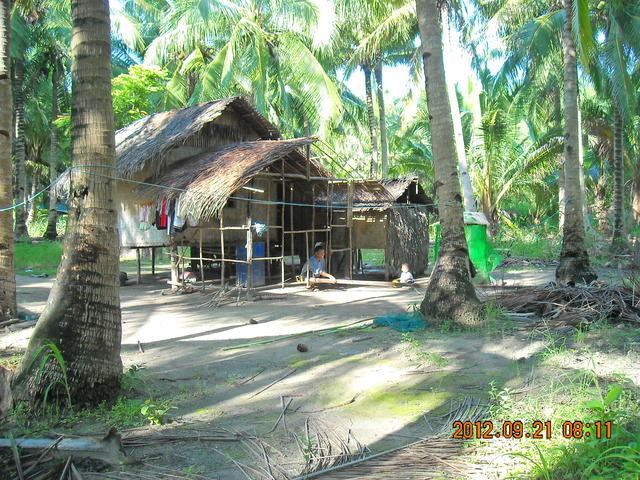
hiked through the village
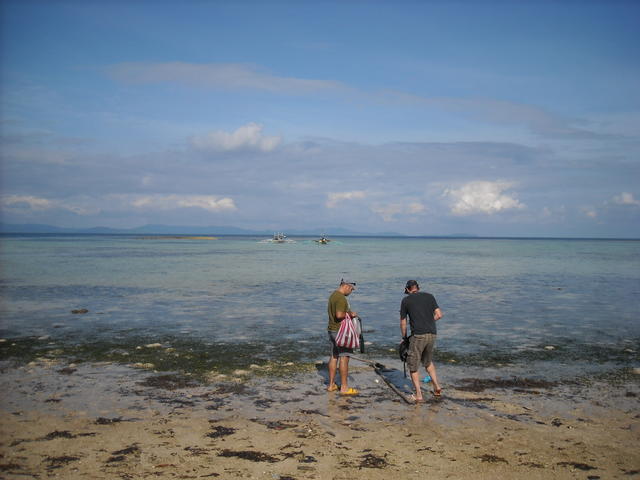
waded across the shallows to get to the boat
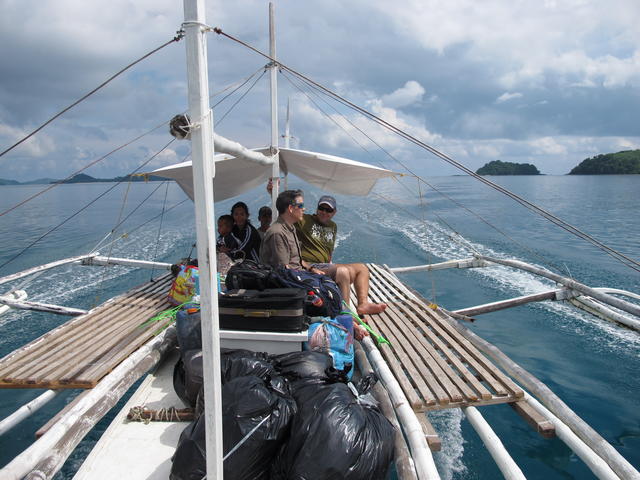
rode the boat back across the ocean and headed home
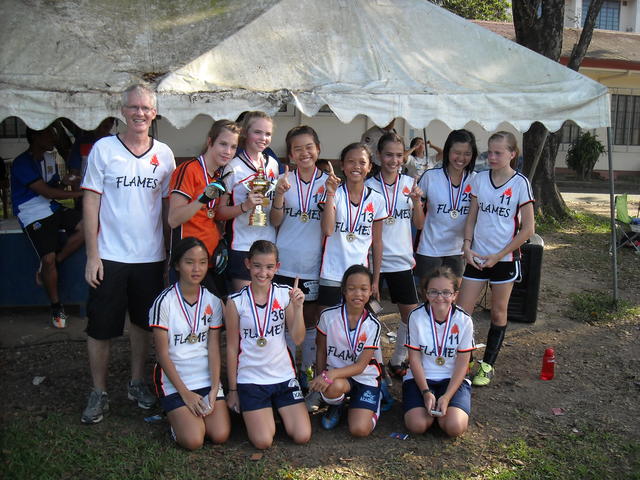
Abby's soccer team won the local select team championship
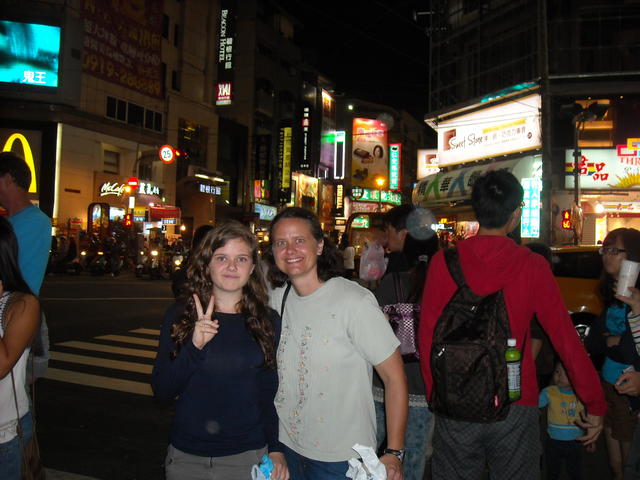
Sarah's school soccer team took a trip to Taiwan to compete in a tournament
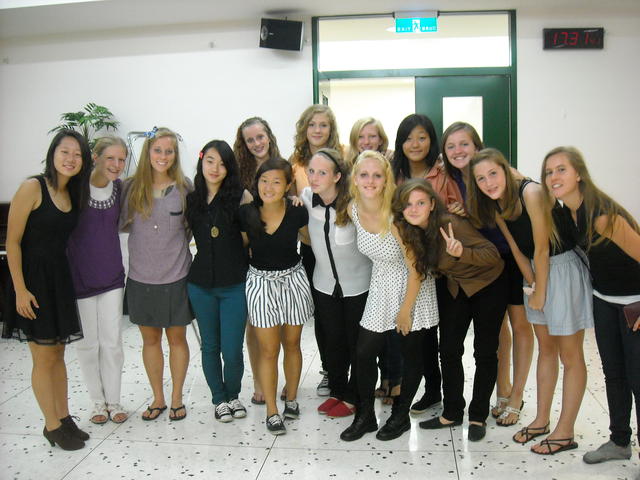
They were tournament champions
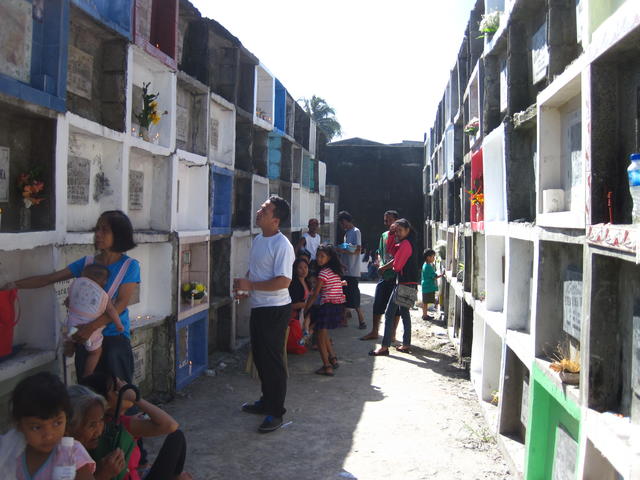
All Soul's Day in the Philippines - people spend the day at the graves of their relatives
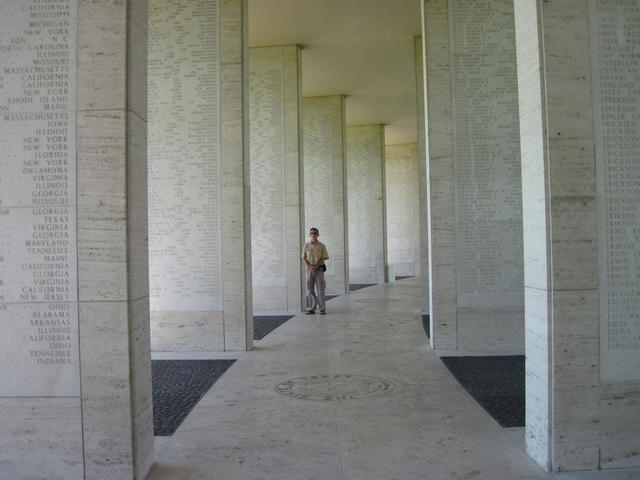
We also visited the American cemetary to remember the sacrifices of soldiers and sailors
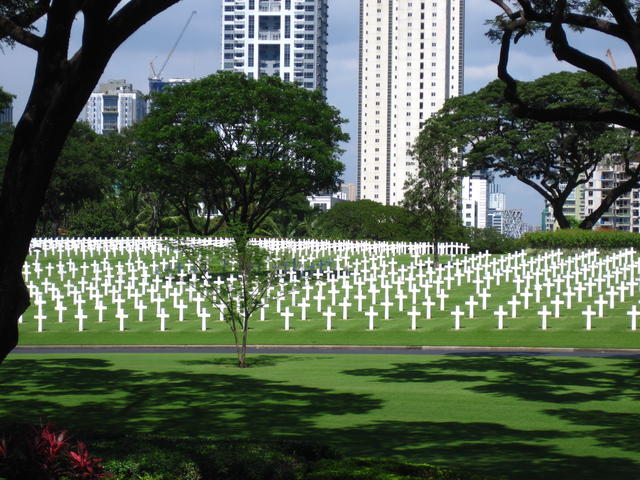
About 50,000 graves here from the Pacific War

I met some Muslims at the airport returning from their Hajj.
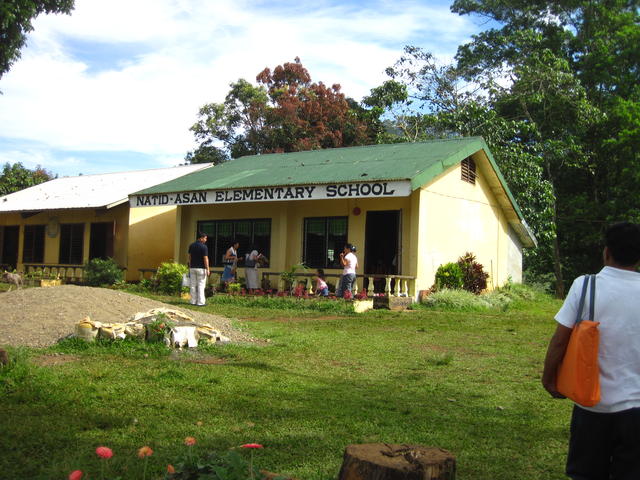
Visited a local school in Mindanao

Teaching the kids in a local school about creation, the fall of man, the Garden of Eden
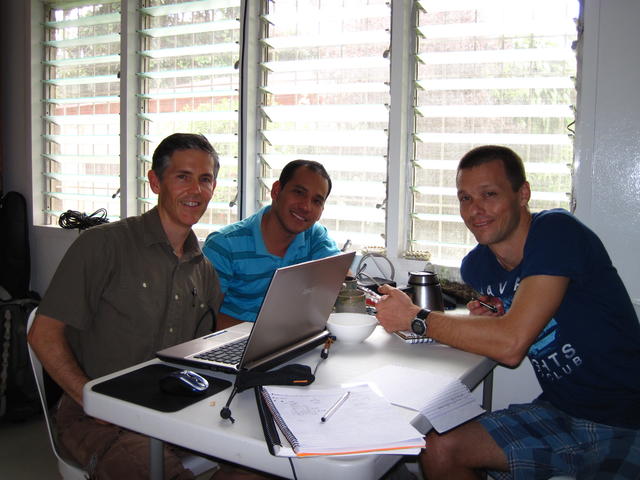
Here we are working on language assessments with a family in Mindanao
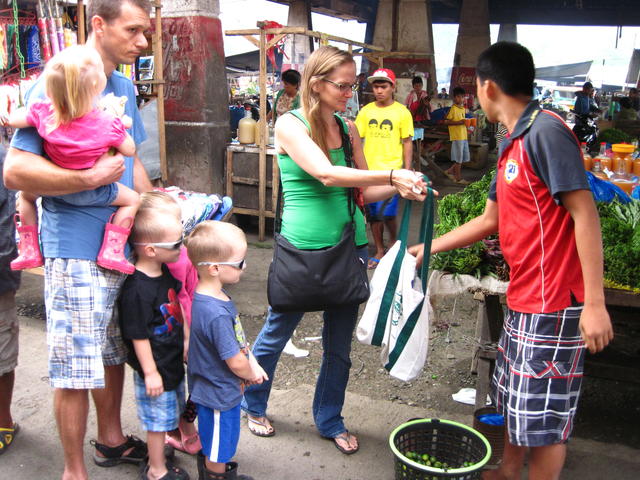
Went to the market with this family
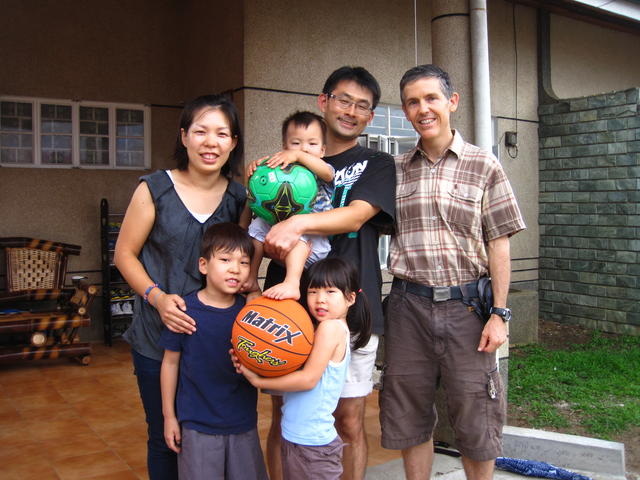
Met with another new missionary family, a Korean couple, eager to serve the Lord in Mindanao
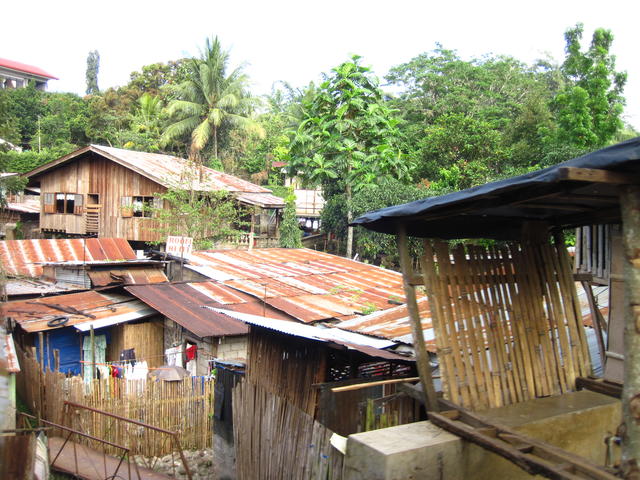
One of the poor areas of Bukidnon
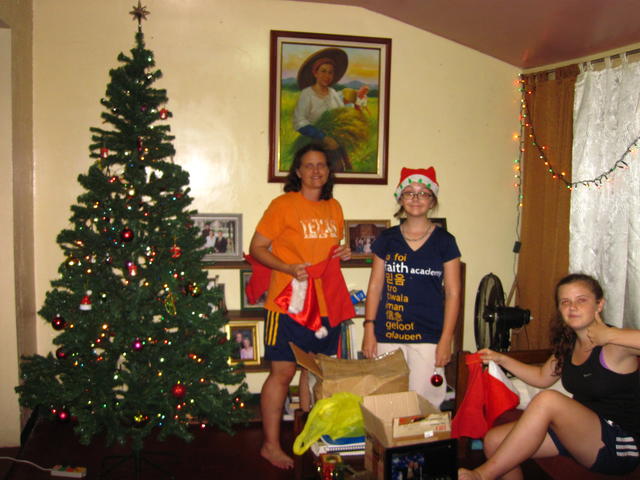
Came home and put up the Christmas tree
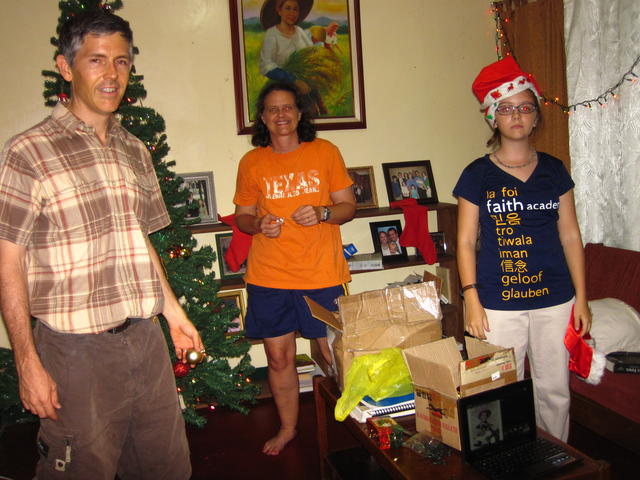
Getting ready for Christmas!
November 25, 2012
Palawan again – week of September 9
As I write this at the end of my travels for the year, I am amazed at the work God is doing. Even though it has been difficult for me to travel while trying to maintain a somewhat restricted diet, the Lord has gone before us in our travels and prepared the way.
This update will encompass the scope of my return to Palawan, a visit into 3 tribal areas, and then finally a visit to Mindanao at the end which I will briefly touch on. It will also include some about Ginny and her work at Faith Academy, and how the Lord is doing great things in our lives. We are incredibly thankful for the goodness of God in allowing us to serve Him, and we pray together with you all we will continue to grow in His wisdom, knowledge, and love!
Return to Palawano for a (very) short visit, week of Sept 16...
When I first took on the job of being a language consultant, it was decided that I should always have someone to accompany me, as it greatly helps in the work. This time, our original plans fell through, so we had to scramble to find an assistant for the consultant visit.
The missionary who trained me to do this kind of work, Jody Crain, was returning to the Philippines for his other ministries for only about a month, so we asked him if he would accompany me. In this way he agreed to come and act as my assistant for this round of evaluations.
I went to Palawan ahead of him so that I could fly to our old tribal area first and make a final walk-through of our house there. There I visited with many Palawano friends and our old partners. I have been out of the Palawano language for over a year, but it quickly just came right back! What a blessing to still be able to recall enough to visit with some of my old friends, although most of them were out in their fields working.
Talking to our old partners was an opportunity to catch up on what is going on there, and they told me a little about the teaching and how the people are receiving it. They are teaching a small group in our old village, and then have plans to soon begin teaching in another village downriver from us. And as of the time of this writing, we have just found out that after presenting the death, burial, and resurrection of Christ, there are 5 new Palawano believers. Wow, praise the Lord!
After about 3 hours in our old location, we (the pilot and I) flew back to Puerto Princesa. Too bad it was so short, but the weather sets in early there, and we had to leave before the rains came or we would not be able to fly. The next day Jody arrived, and together we flew up to the north end of the island to an area where our missionaries are working in the Tagalog language.
Northern Palawan tribal area...
This area in the North is a bit unique for the Philippines. The missionary who started the work here was hoping to begin a work with the Tagbanua tribal people that lived there. Over the years, more and more Filipinos from other areas began moving in. At first the dominant language was Cuyonin (having supplanted the Tagbanua language), but now Tagalog has taken over as dominant with the influx of even more immigrants. So, when partners joined the original missionaries there, they believed it would be best to do the ministry in the Tagalog language. It is unusual for us to have a tribal ministry which is conducted in the national language, but it fits with the needs of the people in this area.
The other uniqueness of this area is that many of the Filipinos there do not have strong family ties. In the Filipino culture, maintaining strong family ties throughout life is the norm, and often grown children with their wives and their own families will be found living with one or more sets of parents and even siblings. However, the people at this end of the island seem to be group of outcasts (sort of). Since they migrated there for one reason or another, they have managed to loosely sever their family ties back to their respective home areas. Also, because Tagalog is the only common language they all share, they practice it and use it every day, and have become highly proficient in it (even though for most of them it is not their first language).
So in this environment, there is a little church where the missionaries are discipling the believers. The missionary we were there to do a final language check on has not been teaching in the church, because our mission requires close to proficient level of certification before teaching in a church. Instead, he has been discipling one on one with some of the leading men in the church, and the reports he gave about the response of the church members to their preaching have been astounding. He told of one instance where he was going through the book of Romans and talking about things that hold us in bondage. He asked the man he was discipling what people are in bondage to in their area. The immediate response was “superstitions.” The following Sunday, this young man was preaching through the book of Romans on how superstitions were keeping them in bondage and preventing them from fully trusting in God. There was an overwhelming response, as people began to discuss how to throw away their dependencies on amulets, good luck charms, and other superstitions in order to trust in Christ alone.
It is very exciting to see God working in people's lives in this way. The missionary there had been doing very well in language and culture studies, and had very strong relationships with the people in the area. The result of the evaluation was that he was clearly ready to move into a preaching and teaching role as necessary for the church.
While we were there, a big typhoon came through the Philippines and the residual effects in our area were very strong. Huge waves were crashing on the beach, and knowing that we were due in a couple of days to cross that ocean on a small boat, we had some cause for concern. I sent a text message to some Christian friends of ours in Manila asking them to pray for our travels, as the storm did not show signs of letting up within the time necessary for us to cross over to the other island.
When the morning came for us to leave our location and drive across the island to the embarkation point, the weather cleared up, but the ocean was still rough at first. We had a text message from the missionary at our destination saying that he thought the weather was calm enough to make the crossing, and he was proceeding out on his boat with the 2 local boat drivers. We arrived at the pick up point about the same time as he was making land, and by that time the weather and the waves were very calm! We made the smoothest crossing I have ever made to that island in record time, praise the Lord! It turned out that at the last minute the typhoon had turned sharply North, and we were left with clear skies and calm seas.
On the island of X…,
We arrived feeling thankful for the Lord going before us in getting us safe to the island. Back to back evaluations are a lot of work, and here we were working with both Nate and Megan, the same couple that we originally came with to the Philippines over 6 years ago. They are good friends of ours, and so it was really nice to visit with them.
This is a small island that has become a center for trade in squid fishing. The fishing has recently become so lucrative that many people from islands all over the Visayas have moved to this area. However, Cuyonin has remained the dominant language here, even though Tagalog is spoken and understood. One of the local people told me that if a new Filipino moves to the island, that person is expected to learn Cuyonin if he or she wants to have friends. So naturally, the missionaries there are also studying Cuyonin.
This time on the island, we were briefed on the team's plans to soon be teaching the Gospel lessons to the islanders. If you remember from earlier this year, the first missionary there for whom we did a language assessment had already reached his required proficiency level in language, and so has been hard at writing Bible lessons to present to the people. He has worked really hard, so that from the time in which he reached the required level to the time in which the Bible lessons were written has only been about 4 months! This is a very exciting time for the island, because soon the people there will hear the message of Christ, when God reached down to restore His relationship to mankind.
Our consultant visit here was to assist the progress of Nate and Megan in their language acquisition, so that they will be able to help the original missionary with the Gospel teaching. They too have been working hard, and are now both at their required proficiency level. After the assessment, we took a boat back to Palawan, caught a bus back to Puerto Princesa, and flew home. Wow, it was a busy month!
One month of not traveling
The month of October gave us an opportunity to catch up on some needed administrative work with the mission, as well as start working on figuring out what is going on with us health-wise. We are also now into the middle of our 2nd year from when we left the tribe to be based out of Manila, and we have found the right niche for our family life and for the ministry. (This is also the beginning of our 7th year in the Philippines.) Ginny is enjoying teaching missionary kids; we are doing well with our girls at home, and when I am at home I am able to continue to press on in deeper acquisition of the Tagalog language. I have learned more and more about how language study never really stops if you want to get really good in it. We now are developing some close friendships with Filipinos in the area, and are enjoying our time together when I am home.
November saw another round of travels (Mindanao)
In November, I was able to travel down to Mindanao and finish a language evaluation on the 2 missionaries studying Visayan down there, Brian and Brooke. They are opening up our Visayan language program for the new folks that choose to work in Mindanao. It was necessary for Brian and Brooke to reach a required proficiency level in speaking Visayan before they started teaching it to others. They have been working very hard for a long time, and they demonstrated their ability well. This is really good news for us, because now we can proceed ahead with our new missionaries studying Visayan.
Just as a reminder for clarification if this is confusing. Here in the Philippines, there are over 170 languages and 3 principal regional trade languages. In the North, the trade language is Ilocano. In the South (Mindanao) and the Visayan Islands, the trade language is Visayan (also called Cebuano). In Central Luzon and Palawan, the trade language is Tagalog, which is also the national language and is spoken throughout the whole country. In New Tribes Mission, we have 2 national language programs for new missionaries – Tagalog for the North and Central part of the country, and Visayan for Mindanao and the Visayan islands.
The reason we don't have an Ilocano language program is that Tagalog is also fairly strong in the Northern Philippines, enough to warrant its usefulness there and over-riding the need for an Ilocano language program.
However, that is not the case in Mindanao; hence, we have a Visayan language program there. After spending almost 2 weeks in Mindanao, I had some observations to make. First of all, compared to the Northern Philippines where you hear Tagalog and Ilocano whenever you go out, here in Mindanao you don't hear Tagalog and Visayan when you go out. You pretty much only hear Visayan. The people understand and can speak some Tagalog because they learn it in school and watch it on TV, but Visayan is still much more dominant here compared to Tagalog. However, when people found out that I could speak Tagalog, they were very eager to practice it with me, because they don't often meet someone to practice Tagalog with. (This is unlike Manila, where most Filipinos want to practice English with me and so I have to work to find people willing to speak Tagalog.) Apparently in this area of Mindanao, fluency in Tagalog brings possibilities of business and opportunity.
So it was great to spend a couple of weeks in Mindanao – the last time I was there was almost 7 years ago when I took Isaac along with me on a survey trip of the tribes in the area. It is hard to believe it was that long ago.
After finishing the evaluations, we spent a week talking through the details of how we are going to structure the Visayan language program for new missionaries. This was a very profitable time, and we are very thankful for Brian and Brooke spearheading this ministry!
Finally...
And as a final report, remember our friends on the island where I did the check in September? Well, we just received the report that they are now teaching the people through the Bible, in the Cuyonin language. So exciting to see the work God is doing there!
Blessings to you all in Christ,
George for all of us
George, Ginny, Isaac, Sarah, & Abby
PICTURES:

Flew into our tribe one last time, said good-bye :(

Saw that our partners were teaching the tribal people to type on the computer so that they can one day develop their own lessons

Flew up to Northern Palawan to visit a tribal area and do language evaluations on the missionaries there

Here is the missionary with one of the young men who is a leader in the church.

Typhoon came through, was blowing really hard

Waves were too big for crossing the ocean

But when it came time to move, the storm subsided

we crossed in calm seas

Here is the precious missionary family studying on the island and preparing to teach the Gospel

Here we are in one of our sessions where we are talking about the language and culture of the island

They got me to play basketball - the last time I played basketball was in junior high, I think, and they called me dr. J (for dr joke)

We do more than just language assessments - I had an opportunity to help Nate out with his solar electric system

Where they are beginning to let the kids in the village learn to read and write

The family had a pet crow that was very friendly

Lady came by selling a lobster she had just caught

Upon leaving, we said good by and hiked out

hiked through the village

waded across the shallows to get to the boat

rode the boat back across the ocean and headed home

Abby's soccer team won the local select team championship

Sarah's school soccer team took a trip to Taiwan to compete in a tournament

They were tournament champions

All Soul's Day in the Philippines - people spend the day at the graves of their relatives

We also visited the American cemetary to remember the sacrifices of soldiers and sailors

About 50,000 graves here from the Pacific War

I met some Muslims at the airport returning from their Hajj.

Visited a local school in Mindanao

Teaching the kids in a local school about creation, the fall of man, the Garden of Eden

Here we are working on language assessments with a family in Mindanao

Went to the market with this family

Met with another new missionary family, a Korean couple, eager to serve the Lord in Mindanao

One of the poor areas of Bukidnon

Came home and put up the Christmas tree

Getting ready for Christmas!
time to reset this
I have not been consistent about posts on this blog, so I am going to post some of the events since my last post 8 months ago, and then put in a current post.
Subscribe to:
Posts (Atom)
